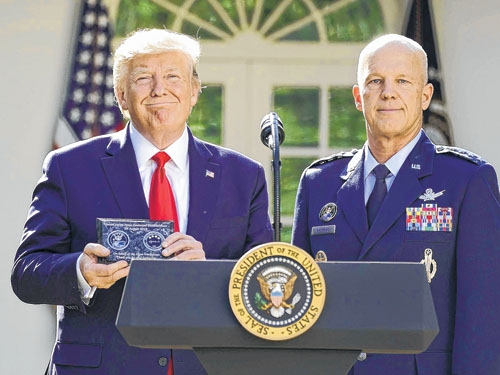Trump launches US Space Command in counter to Russia, China threats

WASHINGTON, Aug 30
President Donald Trump on Thursday took a key step toward reorganizing the nation's armed forces to focus more on the threats posed in space, formally establishing the United States Space Command, the first new combatant command created in more than a decade.
In a 10-minute ceremony in the Rose Garden, Trump called the command's creation a "landmark moment" in protecting America's assets in space and said it would help "defend America's vital interests in space, the next warfighting domain, and I think that's pretty obvious to everybody. It's all about space."
The White House is still working toward persuading Congress to create a Space Force, which would become the sixth branch of the military and the first new one since the Air Force was created in 1947. The House and Senate have provisions for a Space Force in their Pentagon spending bills, but they differ on some key details, such as how the force would be organized.
In June, the Senate confirmed Air Force Gen. John Raymond as the leader of Space Command. Raymond told reporters in a briefing before the ceremony that protecting America's assets in space, including the satellites the military depends on a range of things from missile defense to communications, was a critical mission of the new command.
"I really believe we are at strategic inflection point, where there is nothing that we do in the joint coalition force that isn't enabled by space. Zero," he said.
The U.S. Space Command is the nation's 11th combatant command. Others include geographic commands, such as Central Command, Africa Command and Indo-Pacific Command, which oversee operations in the Middle East, Africa and Asia, respectively; and functional commands, such as Transportation Command, which oversees logistics across the military, and Strategic Command, which controls the nuclear arsenal. Before Thursday, Africa Command was the most recently created, in 2007.
As of Thursday, Space Command counted 287 personnel assigned to it, largely made up of those currently deployed with a unit of U.S. Strategic Command devoted to space. Raymond said the Air Force is still deciding where to locate Space Command's headquarters among six U.S. bases.
The United States military has had a Space Command before. It was launched in 1985 and disestablished in 2002 as the Pentagon reorganized in the wake of the Sept. 11, 2001, attacks. Raymond said the new version is a "different command built for a different environment." In particular, he cited advances by Russia and China that have rendered space a contested domain where the United States faces threats that it didn't before, from the jamming of GPS and communications satellites to the possibility those satellites could be shot down. He cited a 2007 test in which China used a missile fired from Earth to destroy one of its own weather satellites.
Fighting extraterrestrial life in outer space is not one of the new command's missions, said Stephen Kitay, the deputy assistant secretary of defense for space policy.
"Space Command and the United States Space Force, at the end of the day, is focused on life here on Earth, because space does impact . . . our way of war and our way of life," Kitay said. The Washington Post
Israel escalates its shadow war
Jerusalem, Aug 30: Israel has carried out a series of attacks across the Middle East in recent weeks to prevent Iran from equipping its Arab allies with precision-guided missiles, drones and other sophisticated weapons that could challenge Israel’s defenses. The attacks represent a new escalation in the shadow war between Iran and Israel, which has broken into the open and threatens to set off a wider confrontation.
In one 18-hour period over the weekend, an Israeli airstrike killed two Iranian-trained militants in Syria, a drone set off a blast near a Hezbollah office in Beirut’s southern suburbs and an airstrike in al-Qaim, Iraq, killed a commander of an Iran-backed Iraqi militia.
Israel accuses Iran of trying to establish an overland arms-supply line through Iraq and northern Syria to Lebanon. The attacks were aimed at stopping Iran and signaling to its proxies that Israel will not tolerate a fleet of smart missiles on its borders, analysts said. Agencies